- Despite threats by US President Donald Trump earlier in April that he could fire Fed Chair Jerome Powell, he later backed down and clarified on 22 April that he had “no intention” of firing him. Following on from the announcement of tariffs on 2 April, Powell said “the level of the tariff increases announced so far is significantly larger than anticipated” and that the lingering uncertainty around tariffs could inflict lasting economic damage. He stated, “We may find ourselves in the challenging scenario in which our dual-mandate goals are in tension.” He noted that growth appeared to be slowing, but made clear that the Fed could wait for greater clarity. The Fed is widely expected to hold rates at its next meeting on 6-7 May.
- The dollar index was down again in April and was approximately -4.37% MTD. The dollar fell due to weakening economic data and uncertainty over US tariffs.
- The US labour market continued to show strength with Nonfarm payrolls increasing 228,000 in March, up from the revised 117,000 in February. The unemployment rate edged up to 4.2% in March from 4.1% in February. Average hourly earnings were up 3.8% y/o/y and inflation-adjusted consumer spending climbed 0.7%. However private payrolls grew by just 62,000 in April, far fewer than the 115,000 expected and below the 147,000 new jobs added in March. Headline inflation rose by 0.1% m/o/m, down from February’s 0.2%, while core CPI, excluding food and energy, was up 0.1%, the least since July, and down from February’s 0.2%. Headline CPI came in at 2.4% y/o/y, down from February’s 2.8% and core CPI came in at 2.8% from February’s 3.1%. The Fed’s favourite inflation gauge, the Core Personal Consumption Expenditures (PCE) Price Index, came in at 2.6% in March, down from the 3% increase reported in February. Consumer spending, which accounts for more than two-thirds of U.S. economic activity, surged 0.7% in March after an upwardly revised 0.5% gain in February. Personal consumption expenditures increased 1.8% in Q1, the slowest quarterly gain since Q2 of 2023 and down from a 4% gain in Q4 2024.
- On the growth front GDP for Q1 contracted by an annualised 0.3% This was the first quarter of negative growth since Q1 of 2022. This was largely attributed to a rise in imports, which soared 41.3%, as companies and consumers sought to get ahead of the Trump tariffs implemented in early April. However, the April Flash PMIs showed the US economy still performing, but confidence falling. The Flash Composite PMI in April came in at 51.2. This is still expansionary territory, but it was down from March’s 53.5 and a 16-month low. The Flash Services PMI came in at 51.4, down from March’s 54.4 and a 2-month low. The Flash Manufacturing PMI improved, coming in at 50.7, up from March’s 50.2 and a 2-month high. However, as noted by S&P, sentiment among companies about their output over the coming year fell for a third successive month, dropping sharply to register the least optimistic outlook since July 2022."
- Consumers continue to feel less confident about the current state of and prospects for the US economy. The Conference Board's consumer confidence index fell by 7.9 points in April to 86.0, a thirteen year low. The Present Situation Index—based on consumers’ assessment of current business and labor market conditions—decreased 0.9 points to 133.5. The Expectations Index—based on consumers’ short-term outlook for income, business, and labour market conditions—dropped 12.5 points to 54.4, the lowest level since October 2011 and well below the threshold of 80 that usually signals a recession ahead. The University of Michigan consumer sentiment survey showed that US consumer sentiment fell from a downwardly revised 57.0 to 50.8, its lowest level since June 2022. Consumers anticipated inflation to rise at an annual rate of 4.4% over the next five to 10 years. Short-term inflation expectations rose to 6.5%.
- Longer term Treasury yields rose in April.as Fed funds futures traders are anticipating about four 25 bps rate cuts this year. However, according to the CME FedWatch Tool, there is only a 63.2% chance of a 25-basis-point cut at the June meeting. Fed officials indicated they would be ready to cut interest rates if the labour market weakened. Governor Christopher Waller said he “would expect more rate cuts, and sooner” if unemployment increased.”
Yield swings
The US Treasury curve steepened on the long end in April due to increasing uncertainty created by Trump’s ‘liberation day’ tariffs and whether countries would seek to negotiate these down. The stock market tumbled following the introduction of these tariffs, causing yields to rise as investors appeared to be deleveraging their portfolios following the sudden jump in volatility. US Treasury yields rallied over the last two weeks of April with spreads compressing once the sentiment improved around the tariff outlook.
While every effort has been made to verify the accuracy of this information, EXT Ltd. (hereafter known as “EXANTE”) cannot accept any responsibility or liability for reliance by any person on this publication or any of the information, opinions, or conclusions contained in this publication. The findings and views expressed in this publication do not necessarily reflect the views of EXANTE. Any action taken upon the information contained in this publication is strictly at your own risk. EXANTE will not be liable for any loss or damage in connection with this publication.
本文提供給您僅供資訊參考之用,不應被視為認購或銷售此處提及任何投資或相關服務的優惠招攬或遊說。金融商品交易涉及重大損失風險,可能不適合所有投資者。過往績效不代表未來表現。






